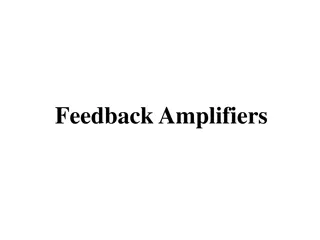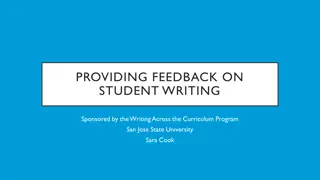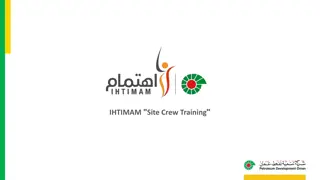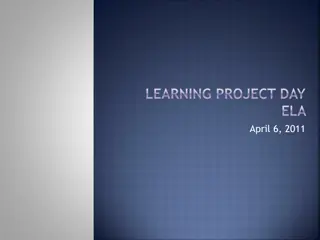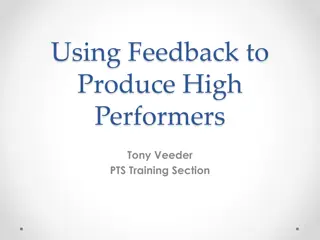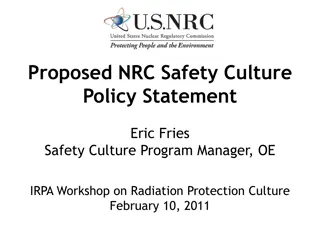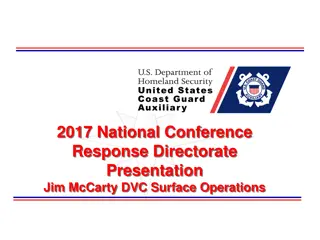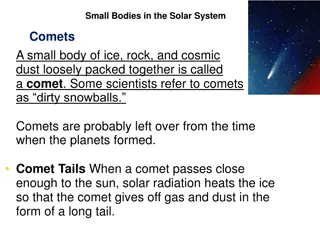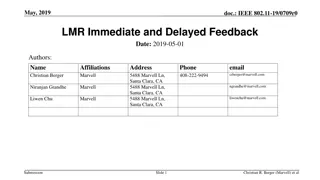Developing an Effective Regulatory Experience Feedback Program for Safety: A Guide for Regulatory Bodies
This Safety Guide aims to assist regulatory bodies in managing regulatory experience by identifying sources, establishing means for information exchange, and implementing record-keeping processes. It addresses the need for cooperation and knowledge sharing among regulatory bodies to enhance safety standards in nuclear installations. Key principles include promoting a safety culture, assessing safety performance, and applying lessons learned from experience. The document interfaces with existing safety publications to ensure alignment with international standards.
Download Presentation

Please find below an Image/Link to download the presentation.
The content on the website is provided AS IS for your information and personal use only. It may not be sold, licensed, or shared on other websites without obtaining consent from the author. Download presentation by click this link. If you encounter any issues during the download, it is possible that the publisher has removed the file from their server.
E N D
Presentation Transcript
Nuclear Safety Standards Committee 46th meeting of the Transport Safety Standards Committee 05 June 2023 Agenda Item 2.1 DPP DS547 for a Safety Guide on Development and Implementation of an Effective Regulatory Experience Feedback Program for Regulatory Bodies for Safety Zia Hussain Shah Division of Nuclear Installations Safety Regulatory Activities Section International Atomic Energy Agency
Background (1/2) Principle 3 of SF-1 calls that the management system also has to ensure the promotion of a safety culture, the regular assessment of safety performance and the application of lessons learned from experience. Requirement 3 para 2.8 GSR Part 1(Rev.1) necessitates the regulatory body to promote cooperation and the exchange of regulatory related information and experience for effective independence in decision making. Requirement 15 of GSR Part 1(Rev.-1) requires that regulatory body shall benefit from operating experience and regulatory experience of other states There is no generic guidance available for RB for development and implementation of an effective and efficient regulatory experience feedback program.
Background (2/2) There is IAEA-TECDOC-1899 for effective management of regulatory experience for safety but is of limited scope and does not cover development and implementation part of regulatory experience. NUSSC in its 52nd meeting agreed that DPPs should be prepared for new Safety Guide on development and implementation of an effective and efficient regulatory experience feedback program for regulatory bodies (a new guide under GSR Part 1).
Objective and Scope This Safety Guide will provide guidance to the Regulatory Bodies for managing regulatory experience in all functions and regulatory processes for facilities and activities in line with the requirements of GSR Part Rev.-1 to: Identify internal and external sources on regulatory experience establish and maintain a means for receiving information from its own functions and processes establish and maintain a means for receiving information from other regulatory bodies and international organizations, and authorized parties Screening process of information received Record keeping, maintaining and utilizing regulatory experience Target audience (e.g. regulatory bodies, TSOs, NPP Operators, design organizations) Regulatory functions, processes and activities related to facilities and activities Review Committees involved: NUSSC, WASSC, RASSC and EPReSC
Interfaces with Existing and/or Planned Publications When drafting the Safety Guide, due account will be given in particular to the following documents: Fundamental Safety Principles, IAEA Safety Standards Series No. SF-1, IAEA, Vienna, (2006). IAEA Safety Glossary: Terminology Used in Nuclear Safety and Radiation Protection, 2018 Edition, IAEA, Vienna (2018) Governmental, Legal and Regulatory Framework for Safety, IAEA Safety Standards Series No. GSR Prat 1, Rev. 1, IAEA, Vienna (2018) Organization, Management and Staffing of the Regulatory Body for Safety, IAEA Safety Standards Series No. GSG-12, IAEA, Vienna (2018) Functional and Processes of the Regulatory Body, IAEA Safety Standards Series No. GSG-13, IAEA, Vienna (2018) Radiation Protection and Safety of Radiation Sources: International Basic Safety Standards, IAEA Safety Standards Series No. GSR Prat 3, IAEA, Vienna (2014) Operating Experience Feedback for Nuclear Installations, IAEA Safety Standards Series No. SSG-50, IAEA, Vienna (2018) Safety of Nuclear Power Plants: Commissioning and Operation, IAEA Safety Standards Series No. SSR-2/2 Rev.1, IAEA, Vienna (2016) Safety of Research Reactors, IAEA Safety Standards Series No. SSR-3, IAEA, Vienna (2016) Safety of Nuclear Fuel Cycle Facilities, IAEA Safety Standards Series No. SSR-4, IAEA, Vienna (2017) Establishing the Safety Infrastructure of a Nuclear Power Programme, IAEA Safety Guide Series No. SSG-16(Rev.1), IAEA, Vienna, (2016). Effective Management of Regulatory Experience for Safety, IAEA TECDOC 1899, Vienna (March 2020) Best Practices in the Utilization and Dissemination of Operating Experience at Nuclear Power Plants, IAEA TECDOC 1580, Vienna (March 2008) Best Practices in the Management of an Operating Experience at Nuclear Power Plants, IAEA TECDOC 1653, Vienna (2010) IAEA Report on Strengthening Nuclear Regulatory Effectiveness in the Light of the Accident at the Fukushima Daiichi Nuclear Power Plant - SSR-5 (2011); GSR-5 (2009); SSG-45 (2019); SSR-6(Rev.1) (2018); SSG-46 (2018); SSG-47 (2018); SSG-55 (2020); SSG-59 (2020); SSG-44 (2018)- Added based on WASSC comments
Proposed Structure An outline contents is set out below, however, the final contents may vary during approval process of DPP and drafting process. 1. Introduction: Background Objective Scope Structure 2. Process for Development and Implementation i. Identification and collection ii. National Operating and Regulatory Experience iii. International Operating and Regulatory Experience iv. Records and storage v. Screening vi. Evaluation vii. Actions and Outcomes viii. Develop and disseminate lessons learned 3. Analysis of effectiveness of operating experience and regulatory experience 4. Dissemination of the lessons learned i. Equipment ii. Human Performance iii. Management System iv. Changes to regulatory requirements 5. Appendices 6. References
Planned Schedule A* DONE August 2022 B* DONE C* DONE STEP 1: Preparing a Draft DPP STEP 2: Internal review of the DPP (Approval by the Coordination Committee) STEP 3: Review of the DPP by the review Committee(s) (Approval by review Committee(s)) Q4.2022 STEP 4: Review of the DPP by the CSS (approval by CSS) or information of the CSS on the DPP STEP 5: Preparing the draft publication and Organizing TM STEP 6: First internal review of the draft publication(Approval by the Coordination Committee) STEP 7: First review of the draft publication by the review Committee(s) (Approval for submission to Member States for comments) STEP 8: Soliciting comments by Member States STEP 9: Addressing comments by Member States STEP 10: Second internal review of the draft publication (Approval by the Coordination Committee) STEP 11: Second review of the draft publication by the review Committee(s) (Approval of the draft) STEP 12: (For Safety Standards) Editing of the draft publication in MTCD and endorsement of the draft publication by the CSS Q1 2023 Q2 2023 Q3 2023 Q4 2023 Q4 2023 Q1 2024 Q2 2024 Q3 2024 Q3 20224 (For nuclear security guidance) DDG s decision on whether additional consultation is needed, establishment by the Publications Committee and editing STEP 13: Approval by the Board of Governors (for SF and SR only) STEP 14: Target publication date Q4 2024
TRANSSC Comments Resolution COMMENTS BY REVIEWER RESOLUTION Reviewer: TRANSSC Member/Experts (Naveed, A. Qavi, M, Amir) Page 01 of 02 Country/Organization: Pakistan/PNRA Date:12-05-2023 Comment No. Para/Line No. Proposed new text Reason Accepted Accepted, but modified as follows Rejected Reason for modification/rejection 1. Section- 2 Para02/ Line-16/ Page-2 (add text) While IAEA safety standards assist countries in developing programmes and processes frameworks for harmonization By sharing experiences and lessons learned with regulatory counterparts from other countries can align their approaches, exchange best practices, and promote regulatory coherence. This harmonization reduces barriers to enhance regulatory effectiveness, and supports international cooperation on regulatory matters. Rejected The harmonization here in this paragraph but it explains the context purpose is not within their regulatory It is a suggestion to make a scale of reporting (like INES) for regulatory OEF which may include violations of international practices, regulatory guides, regulations, ordinance etc. so that member states can share only those events which are credible and need attention. This will help to identify reportable events at the international level. 2. Section- 3 Para-2 Page-3 (Add Justification) Rejected The purpose of this standard is not to develop any scale but to take benefit from the existing systems to practicable in the extent 3. Section- 4 Para-1 Bullet-4 Page-4 (Add text) Establishing processes for screening, and analyzing the information collected or Received for early detection of risk. and evaluating the effectiveness of corresponding activities is added at the end of bullet Section 6 PLACE IN THE OVERALL STRUCTURE.... The IAEA Safety Glossary (2018) may be replaced with 2022 Edition Latest edition of IAEA Safety Glossary 2022 is available. Please take this into consideration Accepted 4. Section 7, OUT LINE OF DPP 5. Please modify the heading no. 3 "Analysis of Effectiveness of and Regulatory Experience..." Heading is not clear Accepted Deleted and 6. Section PRODUCTION SCHEDULE 8, Reconsider the schedule, please, At present we are at 2nd quarter of 2023. Accepted
Thank you! Questions? z.h.shah@iaea.org






